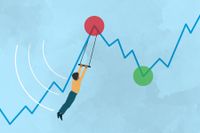Explore web search results related to this domain and discover relevant information.
Equity and index options carry a high level of risk and are not suitable for all investors. Certain requirements must be met to trade options through Schwab. Please read the Options Disclosure Document titled "Characteristics and Risks of Standardized Options" before considering any option ...
Equity and index options carry a high level of risk and are not suitable for all investors. Certain requirements must be met to trade options through Schwab. Please read the Options Disclosure Document titled "Characteristics and Risks of Standardized Options" before considering any option transaction.Keeping you at the forefront of modern investing

We’ve adapted our marketplace to the latest changes so you can keep trading while staying protected. In this post you'll discover how each operation now works on DMarket.
Steam’s recent Trade Protection update changed the way all in-game items are traded. Any item you receive in Steam is now locked for 7 days, during which it can be rolled back (returned to the original owner). We’ve adapted our marketplace to these changes so you can keep trading while staying protected. Here’s how each operation will now work on DMarket:Yes. You can sell instantly as before. However, the funds will only become withdrawable once the item’s Trade Protection timer ends. ... Yes—exchange works instantly, just like before. You can get new items and withdraw them to Steam (if they have no locks or timers).For the initiator of an exchange, the process will feel almost the same as before. After a successful exchange, you can withdraw the new item to your Steam account right away (as long as it has no trade lock or Trade Protection).If an item from the marketplace is bought as part of an exchange (meaning the initiator of the exchange takes it), the payment will be a locked balance, even if the item had no trade lock or Trade Protection.

Video: Top Jobs in Trade Discover the top 10 most in-demand trade jobs in our detailed guide! We have carefully curated a list of the most sought-after trade jobs that are not just high-paying but also provide excellent career prospects.If you're interested in finance, working as a trader might ...
Video: Top Jobs in Trade Discover the top 10 most in-demand trade jobs in our detailed guide! We have carefully curated a list of the most sought-after trade jobs that are not just high-paying but also provide excellent career prospects.If you're interested in finance, working as a trader might be an exciting career choice.This career can provide you with an opportunity to study how different financial industries operate and give you the freedom to choose where you want to work. Learning about the different jobs that a trader can pursue may help you decide if this career path aligns with your professional goals.In this article, we discuss what traders do and list 15 different types of trading jobs, along with their job duties and salaries.Traders buy and sell financial assets to make profits. They perform research to identify trends in the market and base their decisions on the data they produce. Traders work primarily in financial industries, but they can find career opportunities in many sectors.For instance, traders might work with stocks, commodities, foreign currencies or a variety of other types of economic instruments. Some traders work as freelancers or day traders, but many operate as part of a larger trading firm or investment institution.Related: What Is a Day Trader?
Success requires extensive preparation, ... tools—not just the idea you'll work it all out once you've quit your day job. Modern stock trading involves competing against high-frequency trading (HFT) systems that can execute thousands of trades per second, making it nearly impossible ...
Success requires extensive preparation, including about two years of documented profitable part-time trading, zero high-interest debt, healthcare coverage plans, and sophisticated trading tools—not just the idea you'll work it all out once you've quit your day job. Modern stock trading involves competing against high-frequency trading (HFT) systems that can execute thousands of trades per second, making it nearly impossible for individual traders to capitalize on obvious price movements.Before leaving the security of a steady paycheck, it’s essential to understand that trading is more than executing a few good trades. It requires a serious commitment to continual learning, financial discipline, and managing risk to survive the inevitable market downturns. Many who make the leap find themselves ill-prepared for the pressure, leading to financial strain and the cold reality of their dreams not working out. Below, we present five reasons it's not a good idea to make the leap—but then the one reason it might be worth a go.Unlike other professions, where you can gradually build skills and earn a steady income while learning, trading with a small account makes it difficult to diversify or test new strategies without risking a large portion of your capital. That's what dooms most traders early on. The mathematics of risk work relentlessly against the retail trader.HFT's speed advantage is measured in millionths of a second—a blink of an eye is an eternity in comparison. For the average trader working from home with even a decent internet connection, it's like bringing a bicycle to a Formula 1 race.
:max_bytes(150000):strip_icc()/GettyImages-1453648525-7c93ee57c037443abcb1991aebce3a1e.jpg)

Investors with a lot of money to spend have taken a bullish stance on Workday WDAY. And retail traders should know.
The overall sentiment of these big-money traders is split between 62% bullish and 37%, bearish. Out of all of the options we uncovered, there was 1 put, for a total amount of $31,350, and 7, calls, for a total amount of $1,068,658. Based on the trading activity, it appears that the significant investors are aiming for a price territory stretching from $170.0 to $260.0 for Workday over the recent three months.Today, Benzinga's options scanner spotted 8 options trades for Workday.Keep up with the latest options trades for Workday with Benzinga Pro for real-time alerts.20-year pro options trader reveals his one-line chart technique that shows when to buy and sell. Copy his trades, which have had averaged a 27% profit every 20 days. Click here for access. * Maintaining their stance, an analyst from Stifel continues to hold a Hold rating for Workday, targeting a price of $255.
E*TRADE uses features that may not be supported by your current browser and might not work as intended.
Stop waiting. Start investing. Lifelong dreams don't need to take a lifetime with E*TRADE.At E*TRADE, we make it easy to trade stocks, bonds, ETFs, mutual funds, and more. Watch our platform demos or join us live every Wednesday at 11 a.m. ET for a 20-minute getting started webinar. We’ll show you how to place an order, and answer any questions you have during a live Q&A session.Protecting our customers' personal and financial information is one of our top priorities. In addition to some of the most advanced online security available, we offer the E*TRADE Complete Protection Guarantee, which protects your privacy, your assets, and every transaction you make.Choose the type of account you want. Then complete our E*TRADE from Morgan Stanley brokerage or Morgan Stanley Private Bank online application.

A professional trader is a person who works in finance and engaged in investing as a business or in a full-time role rather than occasionally or as a hobby. They may work for themselves, at a trading company, at a wealth management firm or as a freelance trader for individual clients.
For example, a trader may purchase a particular stock for two dollars per share and sell it when it's worth five dollars per share to make a profit. Working in this business may involve duties such as analyzing markets, developing strategies, logging and reviewing individual trades and building relationships with other professionals in the industry.Related: The Basics of Incentive Stock OptionsOptions: Investment contracts that give the trader the right to buy or sell the asset for a specific price by a certain date. Stocks: Investment that represents an ownership share in a company.Once you know in which area you'll be working, you can understand the advanced basics of that specialty.Look for sources that provide charts and examples of how their strategies work over months or years. Note the ones that seem like they could be profitable in your real-world situation.Finding a professional trader who teaches their strategies to others may be helpful.It's also possible to teach yourself trading methods, but it may take longer than working with already available resources. Consider making an outline for your plan as a visual representation and to take notes about what works well in practice or where you can develop your technique. Making trades within a real market may help you make improvements to your theoretical techniques.

This means you have a better idea of what the position entails and complete the tasks in a more effective manner than if you were less sure. This is especially important when considering working as a trader, as they have a significant responsibility in handling finances.
This includes examining the market the trader specialises in, looking through the various stocks and shares that indicate the condition of the market and accounting for global events. Doing research means a trader has a greater level of insight into the current state of the market, whether the value of the market is increasing or decreasing and whether global events have the potential to impact the market they work in.Depending on the company, some traders present these reports to company management and investment strategists in person, informing the strategy of the entire company. This is a role traders share with financial analysts, often seeing traders work alongside people in different roles for more comprehensive analysis.This means traders talk with their clients, explaining the strategies the company uses and presenting their results to them, in addition to providing a forecast for future results. If a trader works specifically on a client's fund, they work personally for them and play a key role in presenting information about their results.The national average salary of a trader is £47,785 per year. Working as a trader means there's potential for performance-related increases in salary, such as earning a commission on sales or a percentage of the profit a trader makes in a given period. Finance is a results-oriented industry, so companies use compensation packages as a means of encouraging employees and finding as many advantages as possible over the competition.

You can be an entrepreneur: Whether you are day trading full-time or just beginning, it provides you with the opportunity to work for yourself. You can make the trades you want and work as often or as little as you'd like.Related: 37 trader interview questions (With sample answers)
Buying in multiple markets: Swing traders can work in various markets, from cryptocurrency to more traditional standard options.Working alone or employing others: You can partake in swing trading alone or hire a trader or automated bot to buy and sell for you.Review the answers to 'What is trading?', learn about the different assets you can trade, three trading strategies and tips to consider in financial trading.Learning more about the different aspects of trading can help you determine whether you're interested in taking part in financial trading. In this article, we discuss what trading is, various assets and instruments you can trade, types of trading strategies and some tips.

Swing trading strategies attempt to capitalize on price fluctuations over the short term. Learn how some traders might use swing trades to attempt to supplement their portfolios.
When bull flag trades work as intended—which is never guaranteed—the trader essentially enters the position as the underlying security takes a pause within a strong uptrend.Many long-term investors tend to focus on the bigger market picture, brushing off day-to-day fluctuations to focus on larger market trends and cycles. But within these larger currents are a multitude of minor price fluctuations: "swings" in the form of smaller rallies and declines. Some traders actually attempt to capture returns on these short-term price swings.Swing trading simply seeks to capture short-term gains over a short period (days or weeks) by attempting to capitalize on dramatic price movements in the underlying security. Swing traders might choose to go long or short the market to potentially capture price swings toward the upside or downside, or between technical levels of support and resistance.In addition, traders must ask themselves why they're buying or selling at a specific price and why the trade's target levels make sense. Because the time constraints of these trades are tight, technical analysis is critical in swing trading.
She has performed editing and fact-checking work for several leading finance publications, including The Motley Fool and Passport to Wall Street. ... There was a time years ago when the only people able to trade actively in the stock market were those working for large financial institutions, ...
She has performed editing and fact-checking work for several leading finance publications, including The Motley Fool and Passport to Wall Street. ... There was a time years ago when the only people able to trade actively in the stock market were those working for large financial institutions, brokerages, and trading houses.However, it's typically challenging for novices and often a losing way for newer investors to trade. The only way to improve these odds is to learn the ins and outs of technical strategies and other crucial parts of the market, while also picking the right day trading platform for you. So, what exactly is day trading, and how does it work?Unlike long-term investors, day traders are less concerned with the fundamental value of the securities and more focused on capturing immediate gains from market fluctuations. Day trading is a high-stakes approach to the financial markets; it involves the rapid buying and selling of securities within a single trading day. This frenetic form of trading works by capitalizing on small price movements in highly liquid stocks or other financial instruments.Day traders, both institutional and individual, would argue that they play an essential role in the marketplace by keeping the markets efficient and liquid. Though day trading will always be intriguing to individual investors, anyone considering it needs to acquire the knowledge, the resources, and the cash that it takes to have a chance at succeeding. ... Investopedia requires writers to use primary sources to support their work.
:max_bytes(150000):strip_icc()/GettyImages-1300319535-47217d4a6a714ef1a8b0562f17bbae9d.jpg)

Traditional market hours are restricted to 9:30 a.m. to 4 p.m. But 24/7 trading offers the ability to trade securities and assets at almost any time.
If you're looking to turn your free time after work into a second shift for building wealth, getting started is easy by following a few important steps: You must first decide what you want to trade to find the platform that best suits your 24/7 trading goals.To execute 24/7 trading, investors must use special trading platforms. Most U.S. equities still trade during the standard trading hours, but even the major markets like the NYSE and Nasdaq are expanding with pre-market and after-hours trading and exploring 24/7 trading in the future.Platforms like Blue Ocean Alternative Trading System (BOATS) allow investors to trade select U.S. equities on brokerage platforms like Charles Schwab, Clear Street, Webull, and Interactive Brokers (IBKR) after traditional trading hours.U.S. equity securities and traditional exchange-traded funds (ETFs) are becoming increasingly available after hours as long as the asset has enough supply and demand to support trading. Webull, Interactive Brokers, and E-Trade facilitate pre-market trading as early as 4:00 a.m.
Let’s go! Trading involves the buying and selling of financial assets, such as stocks, to earn profits based on the price fluctuations of these assets. There are different types of trading, and traders use various strategies, techniques, and tools to decide when to buy or sell different assets.
This article is a roadmap to help newcomers grasp the basics of what trading is and how it works.Ready to get started? Let’s go! Trading involves the buying and selling of financial assets, such as stocks, to earn profits based on the price fluctuations of these assets. There are different types of trading, and traders use various strategies, techniques, and tools to decide when to buy or sell different assets.The fundamental principle that makes trading work is the connection between supply and demand. When there are more buyers than sellers, demand increases — and so do the prices. When sellers outnumber buyers, demand shrinks, causing prices to fall. This can happen for many reasons: market trends, geopolitical events such as war or economic sanctions, natural disasters like droughts, or technological developments. Additionally, a trader's profit relies on the market price eventually matching their speculation — for example, our trader assumed that airline stock prices would increase again.If the pandemic had continued and all airline companies had collapsed, this speculation would have been wrong, and the trader would have lost money.Trading involves a series of steps. Here's a simplified overview of how trading typically works:Traders have control over their portfolios, strategies, and the timing of their trades.While there are plenty of opportunities with trading, it also carries risks. Market volatility, unexpected events, and fluctuations can lead to losses. Plus, it can be a lot of work — successful trading often requires discipline, a thorough understanding of markets, careful risk management, and continuous learning so that you can adapt to changing market conditions.Take it easy and make sure to keep learning if you think trading is right for you.


The company will trade under the ticker symbol WORK.
Here’s what you need to know about the markets before you start your business day.1. Slack starts trading: Shares in Slack, the workplace messaging tool, will start trading Thursday on the New York Stock Exchange.

U.S. hiring is slowing sharply as President Trump’s erratic and radical trade policies paralyze businesses and raise doubts about the outlook for the world’s largest economy.
Hiring is slowing sharply as President Trump’s erratic and radical trade policies paralyze businesses and raise doubts about the outlook for the world’s largest economy.The revelations in the new data raise questions about the health of the job market and the economy as President Trump pushes forward with an unorthodox overhaul of American trade policy.Trump has discarded decades of U.S. policy that had favored fewer barriers and ever-freer trade. Instead, Trump is imposing hefty import taxes — tariffs — on products from almost every country on Earth.“A notable deterioration in U.S. labor market conditions appears to be underway,’’ said Scott Anderson, chief U.S. economist at BMO Capital Markets. ”We have been forecasting this since the tariff and trade war erupted this spring and more restrictive immigration restrictions were put in place.
Trading is the buying and selling of financial instruments in order to make a profit. These instruments range from a variety of assets that are assigned a financial value that can go up or down – and you can trade on the direction they’ll take.
You can learn how CFD trading works by opening a demo account with us. . Your account will be credited with $20,000 in virtual funds that you can use to practise and build your confidence in a risk-free environment. No withdrawals can be made from this account, as the funds are for enactment purposes only. Choose a market that you’re familiar with, or an asset that you can trade based on your experience and risk appetite.Get exposure to these markets with us by opening a demo account to start practicing and find your bearings on how our platform works. Our risk-free environment enables you to trade on several financial instruments to learn how they move.Trading is the buying and selling of financial instruments in order to make a profit. These instruments range from a variety of assets that are assigned a financial value that can go up or down – and you can trade on the direction they’ll take.The difference between trading and investing lies in the means of making a profit and whether you take ownership of the asset. Traders make profits from buying low and selling high (going long) or selling high and buying low (going short), usually over the short or medium term.

Stock trading is a fascinating activity, but it shouldn't be entered into lightly. Learn how it works and what pitfalls to avoid as a beginner.
Sam has previously written for Investopedia, Benzinga, Seeking Alpha, Wealth Daily and Investment U, and has worked as an editor for Investment U, Wealth Daily and Haven Investment Letter. He is based in Brooklyn, New York. ... Stock trading involves buying and selling shares in public companies — called stocks — to try to make money. You may earn a profit by selling stocks for more than you paid for them. Stock traders watch the short-term price changes of stocks closely, and then they try to buy low and sell high[0]But if you have extra cash and you want to want to learn how to start trading, online brokerages have made it possible to trade stocks quickly from your computer or through mobile apps. But before you dive in, you should make sure you know how the stock market works and the details of trading in it.However, there are also premarket and after-hours sessions — not all brokers allow you to trade during these extended-market hours, but many do. Learn more about after-hours trading. ... Chris Davis is a Managing Editor on the Investing team. He has covered the stock market, investing strategies, investment accounts and cryptocurrency, and his work has appeared in The Associated Press, The Washington Post, MSN, Yahoo Finance, MarketWatch, Newsday and TheStreet.Day trading means playing hot potato with stocks — buying and selling the same stock in a single trading day. Day traders care little about the inner workings of the businesses.

Trading is the buying and selling of securities, typically within a short timeframe. Browse Investopedia’s expert written library to learn more about how it works.
The best day trading platforms that made our list provide excellent apps for analyzing indicators and executing trades on a variety of securities including stocks, cryptocurrency, options, forex, futures, and more.Investing takes a long-term approach to the markets, while trading involves short-term strategies to maximize returns daily, monthly, or quarterly. Investors are more likely to ride out short-term losses, while traders will make transactions that can help them profit quickly from fluctuating markets.How much money you need to begin trading depends on the type of securities you want to buy. Stocks typically trade in round lots, or orders of at least 100 shares. To buy a stock priced at $60 per share, you will need $6,000 in your account. A broker may let you borrow half of that money, but you still need to produce the other $3,000.According to University of California researchers Brad Barber and Terrance Odean, they found that many individual investors hold undiversified portfolios and trade actively, speculatively, and to their own detriment.1 Day traders also can be hit with high brokerage fees and other charges that cut into their profits.
:max_bytes(150000):strip_icc()/tradingrecirc-13a5467262bc42778b75c165092bc12b.jpg)
If you only have time to trade part time, this is a must read. It contains 3 major tips to growing your small account slowly while keeping your job.
Let’s talk about time. At the end of the day, we all have the same 24 hours. If you want to squeeze in an extra 2 hours to trade before going to work, or 30 min before the market closes, it all comes down to very meticulous time management.During the day while at work, I did check on the overall market once a while, but generally speaking, I did not trade while at work. Even if I do, it’s just closing the rest of the position that I had already entered from the morning. Usually that’s if I was trading mid cap and large cap stocks.And for me, that would be around 12pm to 1pm lunch time for me at work. And yes, that means I had to say goodbye to socializing with coworkers at lunch and the amazing lunchtime yoga or gym sessions. But that’s just the kind of sacrifice you might have to make. · During power hour, I actually don’t actively day trade.Most of the time I spend the hour looking for stocks that are closing strong on the day and holding daily key levels. And I would sometimes look to take a swing position overnight. I rarely day trade during the power hour. · The work doesn’t stop there when the market closes.

1.2K votes, 174 comments. people keep asking for strategies. here’s a list. some I've used myself and some come from books in the market wizards…
I trade on the 5m candles, so depending on how many minutes into the candle, it usually sets an even higher high or lower low · more reply More replies More replies More replies More replies ... Micro momentum, nice. More replies ... A smart thing I heard is most strategies are fairly simple and they all work well but applying them properly with the right psychology and using discretion is what's hard.This has been my most successful strat and although yes like literally any other strategy out there, nothing will ever work 100% of the time, with proper risk management you can't really lose with this one. P.S. Additional confirmations like breaking a swing/session/previous day(s) low/high or filling a price imbalance (FVG) in the process of the ORB is even better and only raises the chance of success on this strat. ... How do you decide your position sizing, and do you scale in and out of your trades?A couple strategies that have been working for me in premarket are 2min PB on initial move, 15min pb, red to green color change off 9EMA, and large red candle being taken out by green candle on reversal. I only trade the top 5 or so small cap gappers so volume is high and I only enter a trade if stock is above 9 EMA, 20 EMA and VWAP.It’s just a made up concept by a trader who doesn’t make money from trading but by teaching. And he purposefully makes trading sound much more complicated than it is to convince people that he is the solution to all their problems and that he is the only person who can make them profitable. Real trading simply doesn’t work like what he preaches and fair value gaps aren’t a thing.

:max_bytes(150000):strip_icc()/GettyImages-1453648525-7c93ee57c037443abcb1991aebce3a1e.jpg)
:max_bytes(150000):strip_icc()/GettyImages-1300319535-47217d4a6a714ef1a8b0562f17bbae9d.jpg)



:max_bytes(150000):strip_icc()/tradingrecirc-13a5467262bc42778b75c165092bc12b.jpg)
